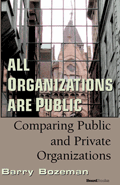|
|
|
|
||||||

|
All Organizations Are Public: Comparing Public and Private Organizations This book will prove fascinating reading to all who have an interest or an involvement in business, economics, or politics. Publisher Comments
This engrossing book takes the position that all organizations, whether they are governmental, business, or not-for-profit, are to one degree or another subject to public authority. Thus, they are all "public" in their basic nature, as they are constrained or empowered by such public authority. No matter what their legal status or institutional context, the public aspects affect their behavior in important ways. After expounding on the roots of economic and political authority, the author uses a multi-dimensional view to show why all organizations are public. Review by David Buzzell Bozeman breaks down the simple, widely-accepted categorization of organizations into either public or private, with the former being government organizations and everything else, private. This view of the innumerable and widely varied organizations in all parts of the United States has held up since at least the latter 1800s even though it is demonstrably inapplicable. It’s plain that not all government organizations are public; the CIA and FBI are but two that can hardly be labeled this. And not all other organizations lumped into the category of private can be said to be this since they operate in one way or another in the public domain and are subject in varying ways to varying degrees to the public’s representative, namely the government. Even in recent decades as government has grown ever larger and more involved in all areas of the society and corporations have become more expansive and changeable with globalization, the simplistic, inaccurate division of public and private continues to hold up. The “sector blurring” Bozeman was seeing when he first wrote this work in the 1980s has increased and accelerated, making All Organizations Are Public a more relevant and useful guide to understanding the topology and workings of today’s organizations that it was when it was first published. The outsourcing of certain tasks traditionally done by American servicemen and women to civilian employees of a business organization is one current example of operations and an organization which cannot fall neatly into the public-private categorization. The more complex relationship at times virtually a cooperation between government and corporations in the globalization of business is another current example of the “sector blurring” prompting Bozeman to take the measure of what was very noticeably happening with modern-day organizations. He not only reports what has been going on, but also develops concepts and devises principles of use for corporate strategists and managers as well as business school teachers, entrepreneurs considering starting or expanding a business, and government officials. Bozeman’s view of modern organizations rests not on the common and changeable references of popular opinion, the marketplace of ideas, or the phenomena of consumerism, but on the central social reality of “political authority.” In doing away with the conventional, yet misleading categories of public and private, Bozeman does not leave the reader with a vague, cosmic-like view of the field of organizations. The two categories are replaced with an interrelated set of axioms and corollaries bringing a logic and order to the vast and diverse world of organizations. The first axiom is, “Publicness is not a discrete quality but a multidimensional property. An organization is public to the extent that it exerts or is constrained by political authority.” The first corollary to this is, “An organization is private to the extent that it exerts or is constrained by economic activity.” Bozeman recognizes that government i.e., “public”and organizations formed or owned by regular citizens i.e., “private”do have differences. They come into being from different motives and different purposes, and they are related to the public in different ways and operate differently. Nonetheless, the structure and operations of all organizations are affected, and in some cases determined, by the overriding political authority. In Bozeman’s conception, “publicness refers to the degree to which the organization is affected by political authority.” Some are tightly controlled by this political authority, while others are barely touched by it. But no organization is entirely free of such authority. With his axioms and corollaries, Bozeman gives principles and characteristics for apprehending the nature of particular organizations. Today’s research and development (R&D) organizations are a kind of organization that the conventional public-private categorization cannot begin to make sense of. “Research and development organizations provide a fertile ground for analysis of dimensions of publicness.” As hybrids involving aspects of universities, government, and industry, R&D organizations are playing important economic and social roles in such areas as health, the environment, demographics, and welfare. Many are located at universities and run by faculty members. Many corporations have R&D divisions. The value and relevance of Bozeman’s key factor of political authority is seen especially with respect to R&D organizations. Current government policies on stem cell research demonstrate how Bozeman’s central factor of “political authority” is applied to understand any particular organization engaged in such research. It’s a matter of where an organization falls in the spectrum of degrees of being affected by political authority, not the uninformative, sterile decision as to whether an organization should be labeled public or private. Bozeman’s view of organizations takes into account the reality that the term “private” has little meaning with respect to organizations. All organizations, like all citizens, are subject to the political authority somehow, notably the laws and regulations. But Bozeman is not interested simply in arguing for a new theory of organizations. His “multidimensional view of publicness” in tune with the complexity, diversity, and changes among today’s organizations can help readers more effectively steer and develop their own organization and work with other organizations.
|
|
|
|
home
| about
us | contact
us | related
sites |